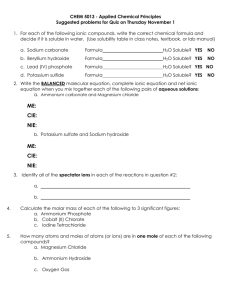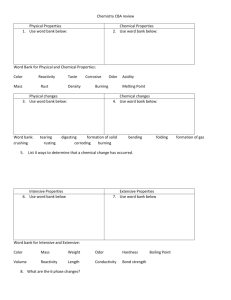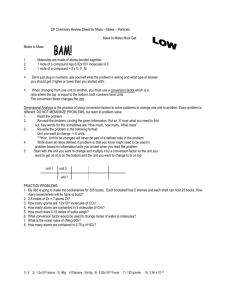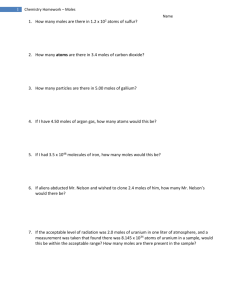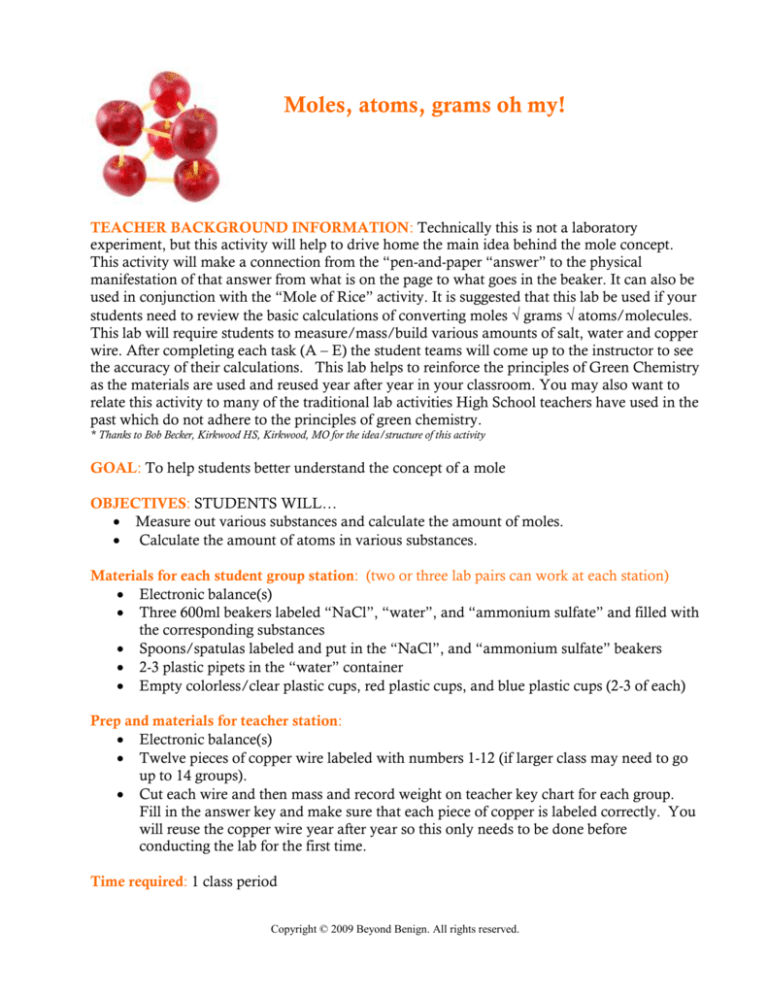
Moles, atoms, grams oh my!
TEACHER BACKGROUND INFORMATION: Technically this is not a laboratory
experiment, but this activity will help to drive home the main idea behind the mole concept.
This activity will make a connection from the “pen-and-paper “answer” to the physical
manifestation of that answer from what is on the page to what goes in the beaker. It can also be
used in conjunction with the “Mole of Rice” activity. It is suggested that this lab be used if your
students need to review the basic calculations of converting moles grams atoms/molecules.
This lab will require students to measure/mass/build various amounts of salt, water and copper
wire. After completing each task (A – E) the student teams will come up to the instructor to see
the accuracy of their calculations. This lab helps to reinforce the principles of Green Chemistry
as the materials are used and reused year after year in your classroom. You may also want to
relate this activity to many of the traditional lab activities High School teachers have used in the
past which do not adhere to the principles of green chemistry.
* Thanks to Bob Becker, Kirkwood HS, Kirkwood, MO for the idea/structure of this activity
GOAL: To help students better understand the concept of a mole
OBJECTIVES: STUDENTS WILL…
Measure out various substances and calculate the amount of moles.
Calculate the amount of atoms in various substances.
Materials for each student group station: (two or three lab pairs can work at each station)
Electronic balance(s)
Three 600ml beakers labeled “NaCl”, “water”, and “ammonium sulfate” and filled with
the corresponding substances
Spoons/spatulas labeled and put in the “NaCl”, and “ammonium sulfate” beakers
2-3 plastic pipets in the “water” container
Empty colorless/clear plastic cups, red plastic cups, and blue plastic cups (2-3 of each)
Prep and materials for teacher station:
Electronic balance(s)
Twelve pieces of copper wire labeled with numbers 1-12 (if larger class may need to go
up to 14 groups).
Cut each wire and then mass and record weight on teacher key chart for each group.
Fill in the answer key and make sure that each piece of copper is labeled correctly. You
will reuse the copper wire year after year so this only needs to be done before
conducting the lab for the first time.
Time required: 1 class period
Copyright © 2009 Beyond Benign. All rights reserved.
Standards Met: S1, S2
Green Chemistry Principles Covered: 1, 2
Procedure:
Ask students to give their definition of the mole concept.
Pass out copies of the student work sheet (half a page). Each group will be assigned a
different group number. Each group will have different amounts to mass and calculate.
Review the lab directions with the students.
Inform students that in this activity each group will be graded on how accurately and
precisely they complete the task. You can give them one “re-do.”
As groups complete their task they will bring the sample up to you for quick scoring.
This will involve the instructor weighing the sample the groups bring up and seeing
where the mass falls on the scoring standard table that the instructor has made before
the activity. The best way to do this is to have a clean dry cup on the scale that matches
the color of the ones the students bring up. You will tare out the mass of the cup before
putting the group’s sample in. Any group that has forgotten to eliminate the mass of
their cup before their calculations will quickly see their mistake.
Example: Group 3 comes up with their clear cup containing their sample of 1.51 moles
of salt and it weights 88.62. This would earn the group a score of “4” since it falls in the
top range. A group that may have forgotten to take in the mass of the cup could come
up and their sample may have weighed 76.34 g of NaCl. Since this score falls outside of
the lowest range they would get a score of a “1”. They could use their “redo” chance
here.
After circling the score on their sheet, you can then pour the salt sample back into their
cup and instruct them to recycle it back into the large container at their lab station. This
prevents any waste in the lab and can be used again for the next class and for classes
again the next year.
Task C is different. The groups must come up to the teacher desk and get their
numbered copper wire piece from the pile there. The groups will take it back to their
station to weigh it and then come back to return it to the teacher’s desk along with their
calculation of how many atoms it contains. After students have shown you their
models, ask them to break the models down and store them back in their kit boxes.
A common mistake that may be seen in Task E is the students may forget to balance the
charges on the compound. This will throw off their answer.
When students are finished they simply have to turn in their sheets, return their
materials to the appropriate container s at their stations.
Copyright © 2009 Beyond Benign. All rights reserved.
Moles, atoms, grams oh my!
Teacher Data Sheet
Cu Piece
#1
#2
#3
#4
#5
#6
#7
#8
#9
#10
#11
#12
mass (g)
4.21
4.75
4.98
5.12
5.45
5.98
6.08
6.55
6.78
7.12
7.64
7.87
The above are mass amounts for
the copper wire. You may not
get exactly these amounts when
you cut the wire, but use this
guide as an estimate of how
much to cut for each group and
then make sure that you put your
exact amounts down for your
reference.
Teacher Data Table Key: The instructor will need to make up a key ahead of time for each
group. This may take some time, but once it is done this key can be used forever. Just take the
student group half sheets and make a permanent answer sheet, but remember that in Task C
you will need to use the amount of copper wire that you cut for each group.
Sample calculation for Group #1 Task A
A. Measure out 1.25 moles of salt (NaCl) into a clear, dry cup.
Show work: 1.25 mol x 58g = 72.5 g
1
1 mol
Copyright © 2009 Beyond Benign. All rights reserved.
Moles, atoms, grams oh my!
Student Instruction Sheet
GOAL: To understand the concept of a mole and to calculate mole gram atom/molecules
conversions.
OBJECTIVES:
Measure out in grams of in various substances and calculate the amount of moles.
Calculate the amount of atoms in various substances.
Materials for each group
Electronic balance (one at each station)
Three 600ml beakers labeled “NaCl”, “water”, and “ammonium sulfate” and filled with
the corresponding substances. (One at each station)
Spoons/spatulas labeled and put in the “NaCl”, and “ammonium sulfate” beakers
2-3 plastic pipettes in the “water” container. (One at each station)
Empty colorless/clear plastic cup, red plastic cup, and blue plastic cup - Label with you
group number.
Take your lab calculation half-sheet and proceed with your activity. You must go up to
the instructor’s desk after each task to check for accuracy.
Procedure:
Take your lab sheet and proceed with the instruction on it. Remember that you must
go up to the instructor’s desk after each task to check for accuracy.
Time Required: 50-60 minutes
Copyright © 2009 Beyond Benign. All rights reserved.
Moles, atoms, grams oh my! Group #1
Group members: ________________________________
Complete task A through E, but you must go up to the instructor’s desk after each test to check
for accuracy. You will be awarded points based on your accuracy. Your group will be allowed
one “do-over”.
A. Measure out 1.25 moles of salt (NaCl) into a clear,
w/i 2% w/i 5% w/i 10% you tried
4
3
2
1
dry cup.
Show work:
B.
Put 4.52 x 1024 molecules of water into a red dry cup.
4
3
2
1
4
3
2
1
4
3
2
1
4
3
2
1
Show work:
C.
Obtain a sample of copper metal from your teacher.
Determine how many atoms it contains. Show your work and
Then bring up to teacher to check for accuracy.
Show work:
D.
E.
Measure out and check for accuracy with your instructor
5.15 x 10 22 of aluminum.
Show work:
Measure out 0.0458 moles of ammonium sulfate into
a blue, dry cup.
Show work:
When complete answer the following questions.
1. What is the relationship in this activity to atom economy?
2. Which of the 12 Principles of Green Chemistry does this activity incorporate?
Copyright © 2009 Beyond Benign. All rights reserved.
Moles, atoms, grams oh my! Group #2
Group members: ________________________________
Complete task A through E, but you must go up to the instructor’s desk after each test to check
for accuracy. You will be awarded points based on your accuracy. Your group will be allowed
one “do-over”.
A. Measure out 1.35 moles of salt (NaCl) into a clear,
.
w/i 2% w/i 5% w/i 10% you tried
4
3
2
1
dry cup.
Show work:
B.
Put 4.25 x 1024 molecules of water into a red dry cup.
4
3
2
1
4
3
2
1
4
3
2
1
3
2
Show work:
C.
Obtain a sample of copper metal from your teacher.
Determine how many atoms it contains. Show your work and
Then bring up to teacher to check for accuracy.
Show work:
D.
E.
Measure out and check for accuracy with your instructor
6.15 x 10 22 of aluminum.
Show work:
Measure out 0.0427 moles of ammonium sulfate into
a blue, dry cup.
Show work:
4
When complete answer the following questions.
1. What is the relationship in this activity to atom economy?
2. Which of the 12 Principles of Green Chemistry does this activity incorporate?
Copyright © 2009 Beyond Benign. All rights reserved.
1
Moles, atoms, grams oh my! Group #3
Group members: ________________________________
Complete task A through E, but you must go up to the instructor’s desk after each test to check
for accuracy. You will be awarded points based on your accuracy. Your group will be allowed
one “do-over”.
A. Measure out 1.45 moles of salt (NaCl) into a clear,
.
w/i 2% w/i 5% w/i 10% you tried
4
3
2
1
dry cup.
Show work:
B.
Put 4.12 x 1023 molecules of water into a red dry cup.
4
3
2
1
4
3
2
1
4
3
2
1
4
3
2
1
Show work:
C.
Obtain a sample of copper metal from your teacher.
Determine how many atoms it contains. Show your work and
Then bring up to teacher to check for accuracy.
Show work:
D.
E.
Measure out and check for accuracy with your instructor
6.15 x 10 22 of aluminum.
Show work:
Measure out 0.0448 moles of ammonium sulfate into
a blue, dry cup.
Show work:
When complete answer the following questions.
1. What is the relationship in this activity to atom economy?
2. Which of the 12 Principles of Green Chemistry does this activity incorporate?
Copyright © 2009 Beyond Benign. All rights reserved.
Moles, atoms, grams oh my! Group #4
Group members: ________________________________
Complete task A through E, but you must go up to the instructor’s desk after each test to check
for accuracy. You will be awarded points based on your accuracy. Your group will be allowed
one “do-over”.
A. Measure out 1.27 moles of salt (NaCl) into a clear,
.
w/i 2% w/i 5% w/i 10% you tried
4
3
2
1
dry cup.
Show work:
B.
Put 3.52 x 1023 molecules of water into a red dry cup.
4
3
2
1
4
3
2
1
4
3
2
1
4
3
2
1
Show work:
C.
Obtain a sample of copper metal from your teacher.
Determine how many atoms it contains. Show your work and
Then bring up to teacher to check for accuracy.
Show work:
D.
E.
Measure out and check for accuracy with your instructor
7.15 x 10 22 of aluminum.
Show work:
Measure out 0.0378 moles of ammonium sulfate into
a blue, dry cup.
Show work:
When complete answer the following questions.
1. What is the relationship in this activity to atom economy?
2. Which of the 12 Principles of Green Chemistry does this activity incorporate?
Copyright © 2009 Beyond Benign. All rights reserved.
Moles, atoms, grams oh my! Group #5
Group members: ________________________________
Complete task A through E, but you must go up to the instructor’s desk after each test to check
for accuracy. You will be awarded points based on your accuracy. Your group will be allowed
one “do-over”.
A. Measure out 1.88 moles of salt (NaCl) into a clear,
.
w/i 2% w/i 5% w/i 10% you tried
4
3
2
1
dry cup.
Show work:
B.
Put 3.72 x 1023 molecules of water into a red dry cup.
4
3
2
1
4
3
2
1
4
3
2
1
4
3
2
1
Show work:
C.
Obtain a sample of copper metal from your teacher.
Determine how many atoms it contains. Show your work and
Then bring up to teacher to check for accuracy.
Show work:
D.
E.
Measure out and check for accuracy with your instructor
6.15 x 10 22 of aluminum.
Show work:
Measure out 0.0416 moles of ammonium sulfate into
a blue, dry cup.
Show work:
When complete answer the following questions.
1. What is the relationship in this activity to atom economy?
2. Which of the 12 Principles of Green Chemistry does this activity incorporate?
Copyright © 2009 Beyond Benign. All rights reserved.
Moles, atoms, grams oh my! Group #6
Group members: ________________________________
Complete task A through E, but you must go up to the instructor’s desk after each test to check
for accuracy. You will be awarded points based on your accuracy. Your group will be allowed
one “do-over”.
A. Measure out 1.91 moles of salt (NaCl) into a clear,
.
w/i 2% w/i 5% w/i 10% you tried
4
3
2
1
dry cup.
Show work:
B.
Put 4.33 x 1023 molecules of water into a red dry cup.
4
3
2
1
4
3
2
1
4
3
2
1
3
2
1
Show work:
C.
Obtain a sample of copper metal from your teacher.
Determine how many atoms it contains. Show your work and
Then bring up to teacher to check for accuracy.
Show work:
D.
E.
Measure out and check for accuracy with your instructor
7.25 x 10 22 of aluminum.
Show work:
Measure out 0.0469 moles of ammonium sulfate into
a blue, dry cup.
Show work:
4
When complete answer the following questions.
1. What is the relationship in this activity to atom economy?
2. Which of the 12 Principles of Green Chemistry does this activity incorporate?
Copyright © 2009 Beyond Benign. All rights reserved.
Moles, atoms, grams oh my! Group #7
Group members: ________________________________
Complete task A through E, but you must go up to the instructor’s desk after each test to check
for accuracy. You will be awarded points based on your accuracy. Your group will be allowed
one “do-over”.
A. Measure out 2.22 moles of salt (NaCl) into a clear,
.
w/i 2% w/i 5% w/i 10% you tried
4
3
2
1
dry cup.
Show work:
B.
Put 3.31 x 1023 molecules of water into a red dry cup.
4
3
2
1
4
3
2
1
4
3
2
1
3
2
Show work:
C.
Obtain a sample of copper metal from your teacher.
Determine how many atoms it contains. Show your work and
Then bring up to teacher to check for accuracy.
Show work:
D.
E.
Measure out and check for accuracy with your instructor
7.56 x 10 22 of aluminum.
Show work:
Measure out 0.0389 moles of ammonium sulfate into
a blue, dry cup.
Show work:
4
When complete answer the following questions.
1. What is the relationship in this activity to atom economy?
2. Which of the 12 Principles of Green Chemistry does this activity incorporate?
Copyright © 2009 Beyond Benign. All rights reserved.
1
Moles, atoms, grams oh my! Group #8
Group members: ________________________________
Complete task A through E, but you must go up to the instructor’s desk after each test to check
for accuracy. You will be awarded points based on your accuracy. Your group will be allowed
one “do-over”.
A. Measure out 2.99 moles of salt (NaCl) into a clear,
.
w/i 2% w/i 5% w/i 10% you tried
4
3
2
1
dry cup.
Show work:
B.
Put 3.35 x 1023 molecules of water into a red dry cup.
4
3
2
1
4
3
2
1
4
3
2
1
3
2
Show work:
C.
Obtain a sample of copper metal from your teacher.
Determine how many atoms it contains. Show your work and
Then bring up to teacher to check for accuracy.
Show work:
D.
E.
Measure out and check for accuracy with your instructor
7.95 x 10 22 of aluminum.
Show work:
Measure out 0.0519 moles of ammonium sulfate into
a blue, dry cup.
Show work:
4
When complete answer the following questions.
1. What is the relationship in this activity to atom economy?
2. Which of the 12 Principles of Green Chemistry does this activity incorporate?
Copyright © 2009 Beyond Benign. All rights reserved.
1
Moles, atoms, grams oh my! Group #9
Group members: ________________________________
Complete task A through E, but you must go up to the instructor’s desk after each test to check
for accuracy. You will be awarded points based on your accuracy. Your group will be allowed
one “do-over”.
A. Measure out 2.52 moles of salt (NaCl) into a clear,
.
w/i 2% w/i 5% w/i 10% you tried
4
3
2
1
dry cup.
Show work:
B.
Put 4.29 x 1023 molecules of water into a red dry cup.
4
3
2
1
4
3
2
1
4
3
2
1
3
2
Show work:
C.
Obtain a sample of copper metal from your teacher.
Determine how many atoms it contains. Show your work and
Then bring up to teacher to check for accuracy.
Show work:
D.
E.
Measure out and check for accuracy with your instructor
8.25 x 10 22 of aluminum.
Show work:
Measure out 0.0413 moles of ammonium sulfate into
a blue, dry cup.
Show work:
4
When complete answer the following questions.
1. What is the relationship in this activity to atom economy?
2. Which of the 12 Principles of Green Chemistry does this activity incorporate?
Copyright © 2009 Beyond Benign. All rights reserved.
1
Moles, atoms, grams oh my! Group #10
Group members: ________________________________
Complete task A through E, but you must go up to the instructor’s desk after each test to check
for accuracy. You will be awarded points based on your accuracy. Your group will be allowed
one “do-over”.
w/i 2% w/i 5% w/i 10% you tried
4
3
2
1
A. Measure out 2.11 moles of salt (NaCl) into a clear,
dry cup.
Show work:
B.
Put 3.83 x 1023 molecules of water into a red dry cup.
4
3
2
1
4
3
2
1
4
3
2
1
3
2
Show work:
C.
Obtain a sample of copper metal from your teacher.
Determine how many atoms it contains. Show your work and
Then bring up to teacher to check for accuracy.
Show work:
D.
E.
Measure out and check for accuracy with your instructor
8.55 x 10 22 of aluminum.
Show work:
Measure out 0.0519 moles of ammonium sulfate into
a blue, dry cup.
Show work:
4
When complete answer the following questions.
1. What is the relationship in this activity to atom economy?
2. Which of the 12 Principles of Green Chemistry does this activity incorporate?
Copyright © 2009 Beyond Benign. All rights reserved.
1
Moles, atoms, grams oh my! Group #11
Group members: ________________________________
Complete task A through E, but you must go up to the instructor’s desk after each test to check
for accuracy. You will be awarded points based on your accuracy. Your group will be allowed
one “do-over”.
A. Measure out 2.91 moles of salt (NaCl) into a clear,
.
w/i 2% w/i 5% w/i 10% you tried
4
3
2
1
dry cup.
Show work:
B.
Put 4.03 x 1023 molecules of water into a red dry cup.
4
3
2
1
4
3
2
1
4
3
2
1
3
2
Show work:
C.
Obtain a sample of copper metal from your teacher.
Determine how many atoms it contains. Show your work and
Then bring up to teacher to check for accuracy.
Show work:
D.
E.
Measure out and check for accuracy with your instructor
9.25 x 10 22 of aluminum.
Show work:
Measure out 0.0377 moles of ammonium sulfate into
a blue, dry cup.
Show work:
4
When complete answer the following questions.
1. What is the relationship in this activity to atom economy?
2. Which of the 12 Principles of Green Chemistry does this activity incorporate?
Copyright © 2009 Beyond Benign. All rights reserved.
1
Moles, atoms, grams oh my! Group #12
Group members: ________________________________
Complete task A through E, but you must go up to the instructor’s desk after each test to check
for accuracy. You will be awarded points based on your accuracy. Your group will be allowed
one “do-over”.
A. Measure out 3.11 moles of salt (NaCl) into a clear,
.
w/i 2% w/i 5% w/i 10% you tried
4
3
2
1
dry cup.
Show work:
B.
Put 2.85 x 1023 molecules of water into a red dry cup.
4
3
2
1
4
3
2
1
4
3
2
1
3
2
Show work:
C.
Obtain a sample of copper metal from your teacher.
Determine how many atoms it contains. Show your work and
Then bring up to teacher to check for accuracy.
Show work:
D.
E.
Measure out and check for accuracy with your instructor
9.75 x 10 22 of aluminum.
Show work:
Measure out 0.0354 moles of ammonium sulfate into
a blue, dry cup.
Show work:
4
When complete answer the following questions.
1. What is the relationship in this activity to atom economy?
2. Which of the 12 Principles of Green Chemistry does this activity incorporate?
Copyright © 2009 Beyond Benign. All rights reserved.
1
Copyright © 2009 Beyond Benign. All rights reserved.



